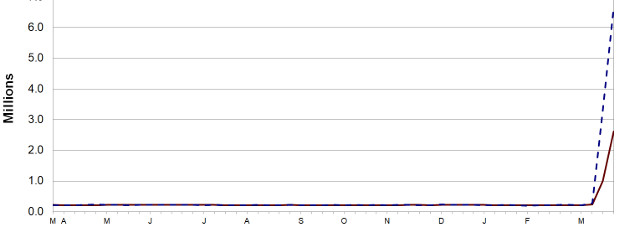Washington, DC…The COVID-19 virus continues to impact the number of initial claims. Nearly every state providing comments cited the COVID-19 virus. States continued to identify increases related to the services industries broadly, again led by accommodation and food services. However, state comments indicated a wider impact across industries. Many states continued to cite the health care and social assistance, and manufacturing industries, while an increasing number of states identified the retail and wholesale trade and construction industries. In the week ending March 28, the advance figure for seasonally adjusted initial claims was 6,648,000, an increase of 3,341,000 from the previous week’s revised level. This marks the highest level of seasonally adjusted initial claims in the history of the seasonally adjusted series.

The previous week’s level was revised up by 24,000 from 3,283,000 to 3,307,000. The 4-week moving average was 2,612,000, an increase of 1,607,750 from the previous week’s revised average. The previous week’s average was revised up by 6,000 from 998,250 to 1,004,250. The advance seasonally adjusted insured unemployment rate was 2.1 percent for the week ending March 21, an increase of 0.9 percentage point from the previous week’s unrevised rate. The advance number for seasonally adjusted insured unemployment during the week ending March 21 was 3,029,000, an increase of 1,245,000 from the previous week’s revised level. This is the highest level for insured unemployment since July 6, 2013 when it was 3,079,000. The previous week’s level was revised down by 19,000 from 1,803,000 to 1,784,000. The 4-week moving average was 2,053,500, an increase of 327,250 from the previous week’s revised average. This is the highest level for this average since January 14, 2017 when it was 2,062,000. The previous week’s average was revised down by 4,750 from 1,731,000 to 1,726,250.
The advance number of actual initial claims under state programs, unadjusted, totaled 5,823,917 in the week ending
March 28, an increase of 2,903,757 (or 99.4 percent) from the previous week. The seasonal factors had expected a
decrease of 23,150 (or -0.8 percent) from the previous week. There were 183,775 initial claims in the comparable week
in 2019.
The advance unadjusted insured unemployment rate was 2.3 percent during the week ending March 21, an increase of 0.9
percentage point from the prior week. The advance unadjusted number for persons claiming UI benefits in state programs
totaled 3,383,382, an increase of 1,308,646 (or 63.1 percent) from the preceding week. The seasonal factors had expected
a decrease of 82,062 (or -4.0 percent) from the previous week. A year earlier the rate was 1.3 percent and the volume was
1,908,355.
3
The total number of people claiming benefits in all programs for the week ending March 14 was 2,105,219, an increase
of 98,832 from the previous week. There were 2,040,256 persons claiming benefits in all programs in the comparable
week in 2019.
No state was triggered “on” the Extended Benefits program during the week ending March 14.
Initial claims for UI benefits filed by former Federal civilian employees totaled 1,282 in the week ending March 21, an
increase of 709 from the prior week. There were 897 initial claims filed by newly discharged veterans, an increase of 461
from the preceding week.
There were 9,792 former Federal civilian employees claiming UI benefits for the week ending March 14, an increase of
148 from the previous week. Newly discharged veterans claiming benefits totaled 5,591, an increase of 384 from the
prior week.
The highest insured unemployment rates in the week ending March 14 were in Alaska (2.8), Connecticut (2.7), New
Jersey (2.6), California (2.4), Massachusetts (2.3), Minnesota (2.3), Rhode Island (2.3), Montana (2.2), Pennsylvania
(2.2), Illinois (2.1), and West Virginia (2.1).
All states reported increases in initial claims for the week ending March 21. The largest increases were in Pennsylvania
(+362,012), Ohio (+189,263), Massachusetts (+141,003), Texas (+139,250), and California (+128,727), while the
smallest increases were in the Virgin Islands (+79), South Dakota (+1,571), West Virginia (+2,671), Vermont (+3,125),
and Wyoming (+3,136).
4
UNEMPLOYMENT INSURANCE DATA FOR REGULAR STATE PROGRAMS
WEEK ENDING March 28 March 21 Change March 14 Prior Year1
Initial Claims (SA) 6,648,000 3,307,000 +3,341,000 282,000 211,000
Initial Claims (NSA) 5,823,917 2,920,160 +2,903,757 251,416 183,775
4-Wk Moving Average (SA) 2,612,000 1,004,250 +1,607,750 232,500 217,250
WEEK ENDING March 21 March 14 Change March 7 Prior Year1
Insured Unemployment (SA) 3,029,000 1,784,000 +1,245,000 1,702,000 1,719,000
Insured Unemployment (NSA) 3,383,382 2,074,736 +1,308,646 1,977,272 1,908,355
4-Wk Moving Average (SA) 2,053,500 1,726,250 +327,250 1,703,500 1,728,750
Insured Unemployment Rate (SA)2 2.1% 1.2% +0.9 1.2% 1.2%
Insured Unemployment Rate (NSA)2 2.3% 1.4% +0.9 1.4% 1.3%
INITIAL CLAIMS FILED IN FEDERAL PROGRAMS (UNADJUSTED)
WEEK ENDING March 21 March 14 Change Prior Year1
Federal Employees (UCFE) 1,282 573 +709 602
Newly Discharged Veterans (UCX) 897 436 +461 480
PERSONS CLAIMING UI BENEFITS IN ALL PROGRAMS (UNADJUSTED)
WEEK ENDING March 14 March 7 Change Prior Year1
Regular State 2,071,070 1,973,584 +97,486 2,006,493
Federal Employees 9,792 9,644 +148 11,079
Newly Discharged Veterans 5,591 5,207 +384 6,068
Extended Benefits3 0 0 0 0
State Additional Benefits4 5,901 5,584 +317 5,854
STC / Workshare 5 12,865 12,368 +497 10,762
TOTAL 2,105,219 2,006,387 +98,832 2,040,256


